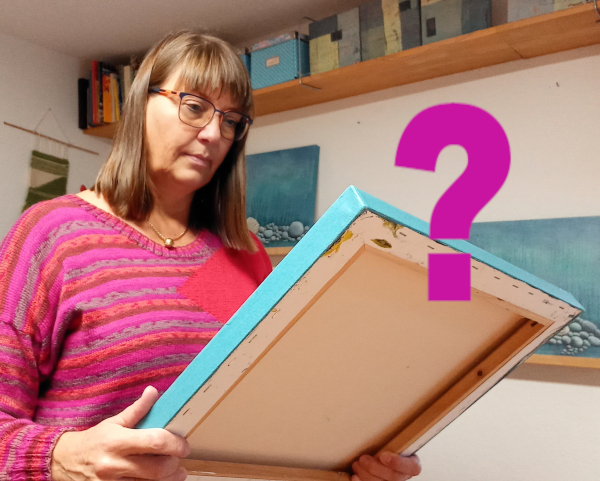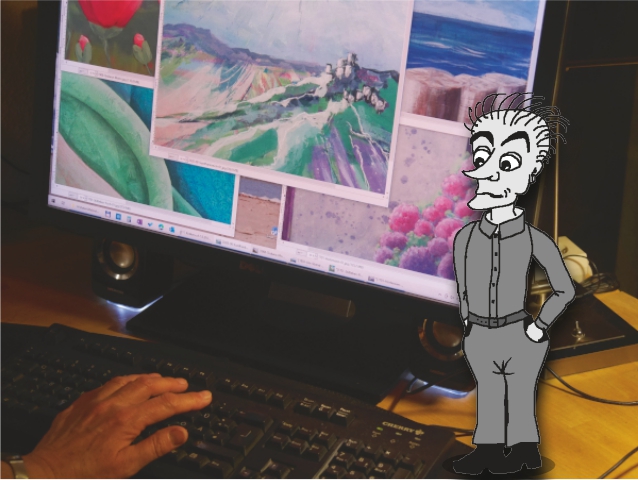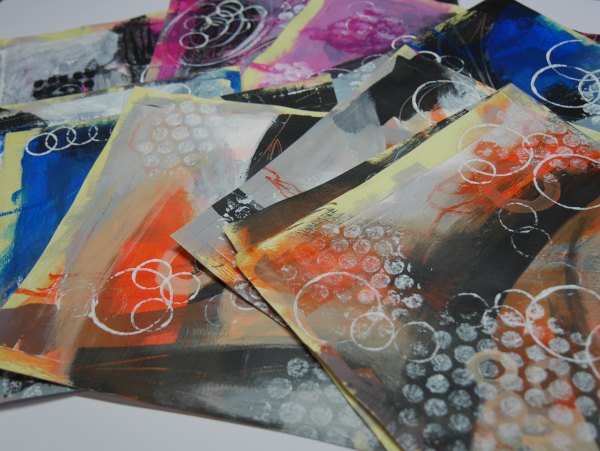“Ist das Kunst oder kann das weg?” – Diesen Spruch kennen wir sicher alle. Aber wir könnten auch fragen: “Ist das Kunst oder nur etwas Dekoratives?” Und wo ist da die Grenze? Darf Kunst nicht auch dekorativ sein? Wer entscheidet das eigentlich?
Ich habe letztens auf YouTube eine Dokumentation gesehen von CampusTV Bayreuth (schaut sie euch gerne hier an), die genau diese Frage stellt: Wann ist eine Arbeit Kunst?
Die Studentin Elisa hat ein kreatives Selbstportrait gemalt und fragt sich, ob sie nun Künstlerin ist. Um das herauszufinden, interviewt sie Personen aus verschiedenen Bereichen der Kunstwelt.
1. Der Medien-Professor
Das erste Gespräch führt Elisa mit ihrem Professor für Digitale Medien nach einer Vorlesung über den Kunstbegriff. Eine mögliche Definition gibt die Institutionelle Theorie der Kunst. Kurz gesagt: Ein Kunstwerk ist ein Werk, das im Kunstbetrieb akzeptiert ist.
Wenn es also von Galeristen, Museumskuratoren, Kritikern etc. als solches wahrgenommen, besprochen und ausgestellt wird, ist es Kunst, und derjenige, der es gemacht hat, ist Künstler. Dabei gibt es keine einheitlichen Kriterien, nach denen geurteilt wird. Vor allem aber liegen die Kriterien nicht innerhalb des möglichen Kunstwerkes.
2. Der Komponist und Dirigent
Musik vergessen wir oft, wenn wir den Begriff “Kunst” verwenden. Im zweiten Gespräch geht es um Kompositionen, Malerei und die Bezeichnung als Künstler*in.
Bei kompositorischen Auftragsarbeiten wird das Recht an der Uraufführung eines Stückes bezahlt, ansonsten werden Tantiemen über die GEMA ermittelt. Wobei diese auch nicht wirklich etwas über den “Wert” des Kunstwerkes aussagen.
Für den interviewten Komponisten ist jemand Künstler, der etwas Kreatives, Neues in die Welt setzt, das andere berührt. Also jeder, der sich kreativ-künstlerisch äußert.
Wenn nur der Kunstbetrieb das Kriterium wäre, würde nichts Neues mehr in die Kunst kommen, sie würde sterben.
3. Die Künstlerin
Ihr ist wichtig, sich selbst frei auszudrücken zu können, egal, ob jemand aus einer Institution das als Kunst bezeichnet oder nicht. Die Arbeiten, die ihr am Herzen liegen, möchte sie gerne mit anderen teilen. Das ist für sie der erste Schritt hinaus auf den “Markt”, also auf den Weg, mit der eigenen Kunst Geld zu verdienen.
4. Der Galerist
Er ist Mittler zwischen Künstler und Käufer. Die Kunst sei schon vorhanden, er mache sie nur sichtbar, sagt er. Aufgrund seiner Erfahrung schätze er das, was er z.B. in Ateliers sieht, ein und entscheide, ob es zu den künstlerischen Positionen seiner Galerie passt.
Für Ausstellungen werden aus einer großen Menge von Werken eines Künstlers die wesentlichen ausgewählt. Diese finanzieren sozusagen die kompletten Arbeiten und damit die Entwicklung des Künstlers.
Der Preis von Kunstwerken hängt ab von Angebot und Nachfrage, ist kein Kriterium für gute Kunst.
5. Der Museumsleiter
Er sagt: Kunst ist, was der Künstler zu Kunst erklärt. Voraussetzung: Dieser ist als Künstler anerkannt von der Gesellschaft, vertreten durch Spezialisten wie Galeristen, Kunstkritiker, Kuratoren.
Aus Museumssicht sind Kunstwerke etwas Gegebenes, deren Qualität von ausgebildeten Fachkräften eingeschätzt wird. Für die Ausstellungswürdigkeit spielen weder der Preis der Werke noch der persönliche Geschmack der Auswählenden eine Rolle.
Ein Museum hat die Aufgabe, Kunst zu zeigen, die eine gewisse gesellschaftliche “Verbindlichkeit” erreicht hat. Experimente sind eher Aufgabe von Galerien und Kunstvereinen.
Fazit
Es gibt ganz unterschiedliche Ansätze, um zu entscheiden, was Kunst bzw. wer Künstler*in ist. Mal geht die Beurteilung von der kreativen Person selber aus, mal von der Gesellschaft, mal ist es ein Zusammenspiel von beidem.
Keine allgemein verbindlichen Kriterien, keine Gesetzmäßigkeiten. Deshalb ist es wohl auch so schwierig, Konsens über Kunst zu finden.
Wie stehe ich zu dieser Frage?
Die ersten Schritte muss ich selber gehen. Ich muss etwas erschaffen, zum Beispiel Bilder, und muss den Mut haben, sie in irgendeiner Form öffentlich zu machen. Die Reaktion darauf – vor allem auch von Fachleuten –zeigt mir, wo ich mich auf meinem künstlerischen Weg befinde. Dann kann ich entscheiden, ob und wie ich ihn weitergehen möchte. Ein Dialog, der sich fortsetzt.
Wie beantwortet ihr für euch die Frage “Was ist Kunst?” Schreibt mir gerne etwas dazu in die Kommentare.
Who decides what art is?

“Is this art or can this go?” – I’m sure we all know this saying. But we could also ask, “Is this art or just something decorative?” And where is the limit? Can’t art also be decorative? Who actually decides that?
I recently saw a documentary on YouTube by CampusTV Bayreuth (you’re welcome to watch it here), which asks exactly this question: when is a work art?
The student Elisa has painted a creative self-portrait and wonders if she is an artist now. To find out, she interviews people from different areas of the art world.
1. The media professor
Elisa has the first conversation with her professor for digital media after a lecture on the concept of art. A possible definition is given by the institutional theory of art. In short: a work of art is a work that is accepted in the art world.
So if it is perceived, discussed and exhibited as such by gallery owners, museum curators, critics, etc., it is art and the person who made it is an artist. There are no uniform criteria by which to judge. Above all, however, the criteria do not lie within the possible work of art.
2. The composer and conductor
We often forget music when we use the term “art”. The second conversation is about compositions, painting and the designation as an artist.
In the case of commissioned compositional work, the right to the world premiere of a piece is paid for, otherwise royalties are determined via GEMA. Whereby these do not really say anything about the “value” of the work of art.
For the composer interviewed, an artist is someone who brings something creative and new into the world that touches others. So everyone who expresses himself creatively and artistically.
If only the art business were the criterion, nothing new would come into art, it would die.
3. The artist
It is important to her to be able to express herself freely, regardless of whether someone from an institution calls it art or not. She would like to share the work that is close to her heart with others. For her, this is the first step out onto the “market”, i.e. on the way to earning money with your own art.
4. The gallery owner
He is the mediator between artist and buyer. The art is already there, he just makes it visible, he says. Based on his experience, he assesses what he sees in studios, for example, and decides whether it fits the artistic positions in his gallery.
For exhibitions, the essential ones are selected from a large number of works by an artist. These finance, so to speak, the entire work and thus the development of the artist.
The price of works of art depends on supply and demand, is not a criterion for good art.
5. The museum director
He says: Art is what the artist declares to be art. Provided: This artist is recognized as an artist by society, represented by specialists such as gallery owners, art critics, curators.
From a museum’s point of view, works of art are given, the quality of which is assessed by trained professionals. Neither the price of the works nor the personal taste of the selector play a role in whether they are worth exhibiting.
A museum has the task of showing art that has achieved a certain social “reliability”. Experiments are more the task of galleries and art associations.
Conclusion
There are very different approaches to deciding what is art or who is an artist. Sometimes the assessment is made by the creative person himself, sometimes by society, sometimes it’s an interaction of both.
No generally binding criteria, no legalities. That’s probably why it’s so difficult to find consensus about art.
Where do I stand on this question?
I have to take the first steps myself. I have to create something, for example paintings, and have the courage to make them public in some way. The reaction to them – especially from experts – shows me where I am on my artistic path. Then I can decide if and how I want to continue. A dialogue that goes on and on.
How do you answer the question “What is art?” Write me something about it in the comments.

